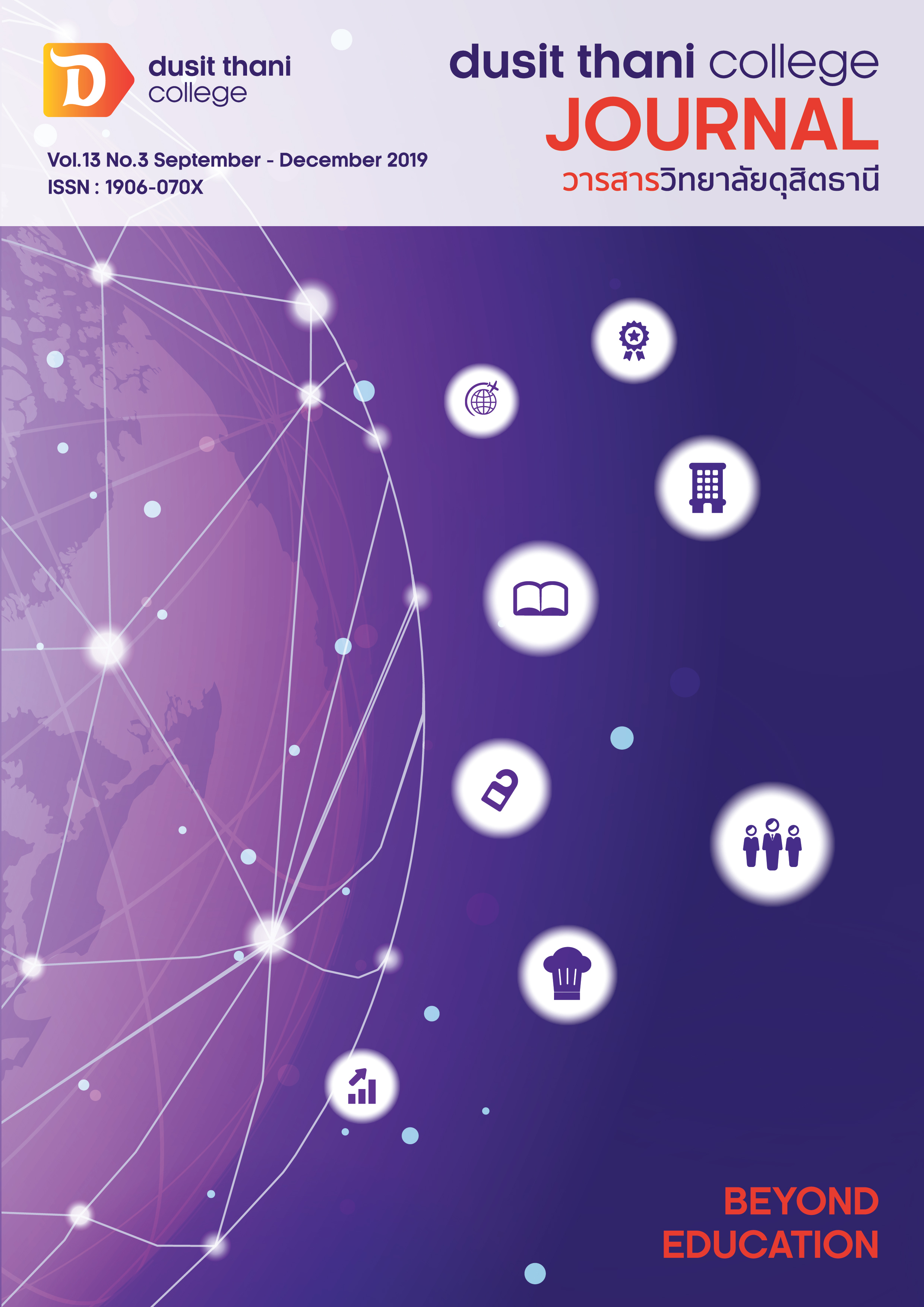อิทธิพลของความพึงพอใจของนักท่องเที่ยว คุณค่าที่รับรู้ ความคุ้นเคย และภาพลักษณ์ ที่มีต่อความภักดีต่อการท่องเที่ยวในพื้นที่ปลายทางประเทศไทย : การศึกษาเปรียบเทียบ ตัวแบบสมการโครงสร้างแบบพหุกลุ่มระหว่างเชื้อชาติของนักท่องเที่ยว
Main Article Content
บทคัดย่อ
การวิจัยครั้งนี้มีวัตถุประสงค์เพื่อศึกษา (1) ภาพลักษณ์ ความพึงพอใจ ความคุ้นเคย คุณค่าที่รับรู้ และความภักดีต่อพื้นที่ปลายทางของนักท่องเที่ยวชาวไทยและชาวต่างชาติ และ (2) เปรียบเทียบตัวแบบสมการโครงสร้างตามกรอบการวิจัยระหว่างกลุ่มนักท่องเที่ยวสัญชาติไทย จีนและเอเชีย และสัญชาติยุโรปและอเมริกา
การวิจัยใช้ระเบียบวิธีวิจัยผสมระหว่างการวิจัยเชิงคุณภาพและการวิจัยเชิงปริมาณ การวิจัยเชิงปริมาณได้ศึกษาและเก็บรวบรวมข้อมูลจากนักท่องเที่ยว 3 กลุ่มสัญชาติ คือ นักท่องเที่ยวชาวไทย นักท่องเที่ยวชาวจีนและเอเชีย และนักท่องเที่ยวชาวยุโรปและอเมริกา รวมจำนวน 544 คน เฉพาะผู้ที่เดินทางมาท่องเที่ยวจังหวัดชายทะเลในประเทศไทยมากกว่า 1 ครั้ง จากจังหวัดภูเก็ต พังงา ชลบุรี และ สุราษฎร์ธานี ซึ่งได้รับการสุ่มเป็นตัวอย่างพื้นที่ปลายทาง
เครื่องมือที่ใช้ในการศึกษาวิจัยเป็นแบบสอบถามวัด 5 ระดับ สถิติที่ใช้ ได้แก่ ร้อยละ ค่าเฉลี่ย ส่วนเบี่ยงเบนมาตรฐาน ค่าสัมประสิทธิ์แปรผัน และการวิเคราะห์ตัวแบบสมการโครงสร้าง (Structural Equation Model--SEM) ส่วนการวิจัยเชิงคุณภาพได้ข้อมูลจากการสัมภาษณ์เชิงลึกแบบกึ่งโครงสร้างผู้ให้ข้อมูลหลักด้านการท่องเที่ยวจำนวน 9 ท่าน วิเคราะห์ด้วยการวิเคราะห์เนื้อหา (Content Analysis)
พบว่าคุณค่าที่รับรู้มีอิทธิพลต่อความภักดีพื้นที่ปลายทางมากที่สุด รองลงมาคือ ความพึงพอใจของนักท่องเที่ยว ภาพลักษณ์ของพื้นที่ปลายทางและความคุ้นเคยกับพื้นที่ปลายทางตามลำดับ รูปแบบอิทธิพลลักษณะนี้จะเป็นแบบเดียวกันกับนักท่องเที่ยวทุกสัญชาติต่างกันที่ขนาดแต่ไม่แตกต่างกันอย่างมีนัยสำคัญเกือบทุกเส้นทาง ตัวแบบรวมสัญชาติก็ยังพบว่ามีรูปแบบตรงกันกับตัวแบบแยกสัญชาติ ผลการวิจัยเชิงคุณภาพจากผู้ให้ข้อมูลหลัก 9 คนก็สนับสนุนความจริงดังกล่าว
ผลการวิจัยทั้งเชิงปริมาณและเชิงคุณภาพทำให้ทฤษฎีที่ได้จากข้อมูล/ สารสนเทศ (Grounded Theory) ดังนี้คือ “คุณค่าที่รับรู้ของนักท่องเที่ยวเป็นปัจจัยที่เปลี่ยนแปลงความสัมพันธ์ระหว่างทรัพยากรท่องเที่ยวกับความภักดีต่อพื้นที่ท่องเที่ยวปลายทาง”
Article Details
นโยบายการพิจารณากลั่นกรองบทความ
- บทความวิจัยและบทความวิชาการทุกเรื่องที่จะได้รับการตีพิมพ์ต้องผ่านการพิจารณากลั่นกรองโดยผู้ทรงคุณวุฒิ (Peer Review) ในสาขาที่เกี่ยวข้อง จำนวน 3 ท่าน/บทความ
- บทความ ข้อความ ภาพประกอบและตารางประกอบที่ลงตีพิมพ์ในวารสารเป็นความคิดเห็นส่วนตัวของผู้เขียน กองบรรณาธิการไม่จำเป็นต้องเห็นด้วยเสมอไป และไม่มีส่วนรับผิดชอบใด ๆ ถือเป็นความรับผิดชอบของผู้เขียนแต่เพียงผู้เดียว
- บทความที่จะได้รับการตีพิมพ์จะต้องไม่เคยตีพิมพ์ เผยแพร่ที่ใดมาก่อน และไม่อยู่ระหว่างการพิจารณาของวารสารฉบับอื่น หากตรวจสอบพบว่ามีการตีพิมพ์ซ้ำซ้อน ถือเป็นความรับผิดชอบของผู้เขียนแต่เพียงผู้เดียว
- บทความใดที่ผู้อ่านเห็นว่าได้มีการลอกเลียนหรือแอบอ้างโดยปราศจากการอ้างอิง หรือทำให้เข้าใจผิดว่าเป็นผลงานของผู้เขียน กรุณาแจ้งให้กองบรรณาธิการวารสารทราบจะเป็นพระคุณยิ่ง
เอกสารอ้างอิง
2. Baloglu, S. (2001). Image variations of Turkey by familiarity index: Informational and experiential dimensions. Tourism Management, 22(2), 127-133.
3. Bigné, J. E., Mattila, A. S., & Andreu, L. (2008). The Impact of Experiential Consumption Cognitions and Emotions on Behavioral Intentions. Journal of Services Marketing, 22(4), 303-315.
4. Castro, C., Armario, E., & Ruiz, D. (2007). “The Influence of Market Heterogeneity on the Relationship Between a Destination’s Image and Tourists’ Future Behavior.
Tourism Management. 28:175-187.
5. Chen, C.-F., and Tsai, D. (2007). How destination image and evaluative factors affect behavioral intentions? Tourism Management 28(4), 1115-1122.
6. Chen, C.-F., and Chen, F.-S. (2010). Experience quality, perceived value, satisfaction and behavioral intentions for heritage tourists. Tourism Management 31(1), 29-35.
7. Chi, C. G., & Qu, H.(2008). Examining the structural relationships of destination image, tourist satisfaction and destination loyalty: An integrated approach Tourism Management 29(4), 624-636.
8. Forgas-Coll, S., Palau-Samwell, R., Sánchez-García, J., & Callarisa-Fiol, L. J. (2012).Urban destination loyalty drivers and cross-national moderator effects: The case of Barcelona. Journal Tourism Management, 33(6), 1309-1320
9. Hair, J. F., Ringle, C.M. and Sarstedt, M. (2011), “PLS-SEM: indeed a silver bullet”, Journal of Marketing Theory and Hawkins, D. I., & Mothersbaugh, D. L. (2010). Consumer Behavior: Building Marketing Strategy (11th ed.). Boston: McGraw-Hill Irwin. Practice, 18(2), 139-152.
10. Hawkins, D. I., & Mothersbaugh, D. L. (2010). Consumer Behavior: Building Marketing Strategy (11th ed.). Boston: McGraw-Hill Irwin.
11. Henseler, J., Hubona, G. and Ray, P.A. (2016) "Using PLS path modeling in new technology research: updated guidelines", Industrial Management & Data Systems, 116(1), 2-20, https://doi.org/10.1108/IMDS-09-2015-0382
12. Kastenholz, E., Carneiro, M. J., Eusébio, C., (2006), Studying visitor loyalty torural tourist destinations .In Kozak, Andreu (Eds.), Progressin Tourism Marketing .Advances in Tourism Research Studies. Elsevier, Oxford, Amsterdam, 239–253.
13. Kotler, P., Bowen, J., & Makens, J. C. (2003). Marketing for hospitality and tourism (3rd ed.). Upper Saddle River, NJ: Prentice Hall.
14. Lee, S., Jeon, S., and Kim, D. (2011). The impact of tour quality and tourist satisfaction on tourist loyalty: The case of Chinese tourists in Korea. Tourism Management, 32(5), 1115-1124.
15. Liu, Y., and Zhou, X. (2009). Corporate social responsibility and customer loyalty:
A conceptual framework. Paper presented at the Proceedings of the 2009 6th International Conference on Service Systems and Service Management, ICSSSM '09.
16. Matzler, K., Bailom, F., Hinterhuber, H. H., Renzl, B., & Pichler, J. (2004). The asymmetric relationship between attribute-level performance and overall customer satisfaction: A reconsideration of the importance-performance Analysis. Industrial Marketing Management, 33(4), 271-277.
17. Mechinda P., Serirat, S., & Guild, N. (2009). An examination of tourists’ attitudinal and behavioral loyalty: Comparison between domestic and international tourists.
Journal of Vacation Marketing, 15(2), 129-149.
18. Milman, A., & Pizam, A. (1995). The role of awareness and familiarity with a destination: The central Florida case. Journal of Travel Research, 33(3), 21-27.
19. National Reform Council, (2015). Tourism Development. Bangkok : Bureau of Printing
The Secretariat of the House of Representatives.
20. Ngamsom B. (2001). The impacts of a bundle of travel determinants on repeat visitation: An Exploratory study of tourism in Thailand. Unpublished doctoral thesis Oklahoma State University Oklahoma.
21. Oppermann, M. (2000). Tourism destination loyalty. Journal of Tourism Research, 39, 78-84.
22. Plog, Stanley C. (1974). Why Destination Areas Rise and Fall in Popularity. The Cornell Hotel and Restaurant Administration Quarterly. 14(4), 55-58.
23. Rittichainuwat, B.N. and Chakraborty, G. (2009). Perceived travel risks regarding terrorism and disease; the case of Thailand. Tourism Management, 30(3), 410-418.
24. Shoemaker, S. and Lewis, R. (1999). Customer loyalty: The future of hospitality marketing. Hospitality Management, 18, 349.
25. Snepenger, D., & Snepenger, M. (1993). Information search by pleasure travelers. In M. A. Kahn, M. D. Olsen & T. Var (Eds.), Encyclopedia of Hospitality and Tourism (830-835). New York, NY: Van Nostr and Reinhold.
26. Thiumsak, T. & Ruangkanjanases, (2016). Factors influencing international visitors to revisit Bangkok, Thailand. Journal of Economics, Business and Management, 4(3), 220-230.
27. Yoon, Y. and Uysal, M. (2005), an examination of the effects of motivation and satisfaction on destination loyalty: A structural model. Tourism Management, 26(1), 45-56.


